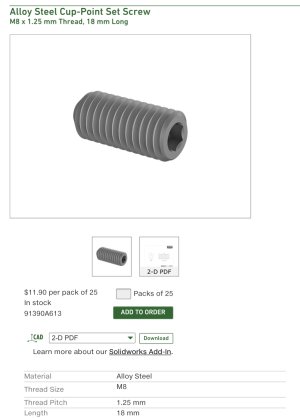Tomc938
Ultra Member
As I mentioned a few days ago, I got a 4 jaw chuck for my Craftex 9x18 lathe. The lathe backing plate has three holes, and the chuck has four. The alignment boss lined up very well, as did one hole. I was a little concerned that one bolt holding the chuck on might not be sufficient. ;o)
So I was faced with the question of drilling 3 extra holes on the lathe backing plate, or 2 more in the lathe body. In the end I decided to make the 2 new holes in the chuck body as it would fit in my milling machine better that the lathe backing plate and spindle. It is worth mentioning that the bolts are not located with much precision - the boss aligns the chuck. The bolts are to keep the chuck from coming off and killing the operator.
The first challenge I would have would be locating the 2 new holes on the chuck. I could mount my rotary table and attack things that way. But it is probably more precision (and hassle) than the two holes are worth.
Fusion 360 is really good at making circular bolt patterns with quite high precision, so I modelled a ring with three holes to see how well it would line up with the existing 3 jaw chuck. The ring (and a collet wrench I was prototyping are below) It lined up right on as far as I could tell by eye, and there was plenty of slack from the clearance holes in the backplate.


I was concerned about how I would get the template to line up with the back of the chuck properly. A small alignment error around the perimeter would make for a larger error on the location of the holes. Then I realized that Fusion can make circular patterns with 4 AND 3 evenly spaced holes - on the same ring! So I modified the model to include both bolt patterns on one ring and increased the height of the shoulder around each of these holes. Now I can bolt the pattern to the four holes on the back of the chuck and use a transfer punch for the two holes I need to drill and tap. Below is a picture of the template alone, and then it mounted on the chuck.


I'll need to make a 9 mm transfer punch, drill and tap carefully, and I think I'll be off to the races!
I will be out of town, and busy for the next few weeks, but I will keep you posted on progress.
If you see any glaring issues I overlooked, please chime in. A second (and 3,4,5) set of eyes and perspective is appreciated.
PS: BY the marking on the back of my chuck, I think it was made in San Fransisco - American quality! (Or someone with the initials SF, and a cheap engraver, was responsible for quality control - Chinese quality!)
So I was faced with the question of drilling 3 extra holes on the lathe backing plate, or 2 more in the lathe body. In the end I decided to make the 2 new holes in the chuck body as it would fit in my milling machine better that the lathe backing plate and spindle. It is worth mentioning that the bolts are not located with much precision - the boss aligns the chuck. The bolts are to keep the chuck from coming off and killing the operator.
The first challenge I would have would be locating the 2 new holes on the chuck. I could mount my rotary table and attack things that way. But it is probably more precision (and hassle) than the two holes are worth.
Fusion 360 is really good at making circular bolt patterns with quite high precision, so I modelled a ring with three holes to see how well it would line up with the existing 3 jaw chuck. The ring (and a collet wrench I was prototyping are below) It lined up right on as far as I could tell by eye, and there was plenty of slack from the clearance holes in the backplate.
I was concerned about how I would get the template to line up with the back of the chuck properly. A small alignment error around the perimeter would make for a larger error on the location of the holes. Then I realized that Fusion can make circular patterns with 4 AND 3 evenly spaced holes - on the same ring! So I modified the model to include both bolt patterns on one ring and increased the height of the shoulder around each of these holes. Now I can bolt the pattern to the four holes on the back of the chuck and use a transfer punch for the two holes I need to drill and tap. Below is a picture of the template alone, and then it mounted on the chuck.
I'll need to make a 9 mm transfer punch, drill and tap carefully, and I think I'll be off to the races!
I will be out of town, and busy for the next few weeks, but I will keep you posted on progress.
If you see any glaring issues I overlooked, please chime in. A second (and 3,4,5) set of eyes and perspective is appreciated.
PS: BY the marking on the back of my chuck, I think it was made in San Fransisco - American quality! (Or someone with the initials SF, and a cheap engraver, was responsible for quality control - Chinese quality!)

